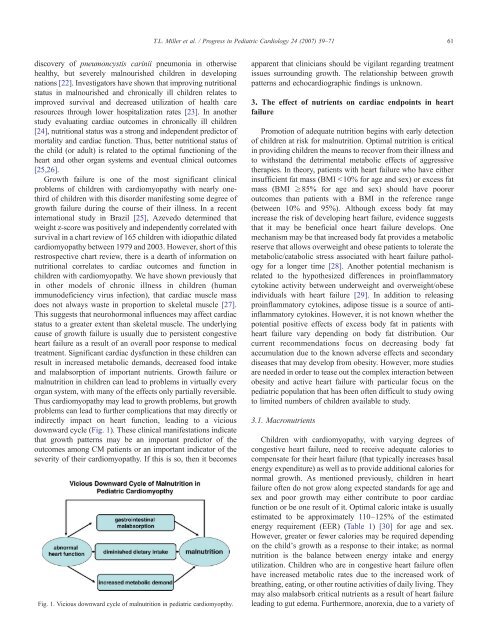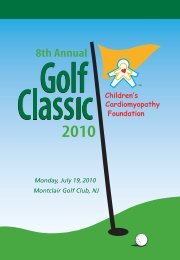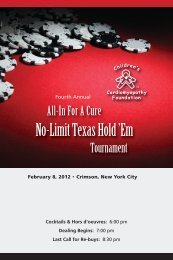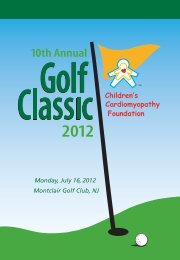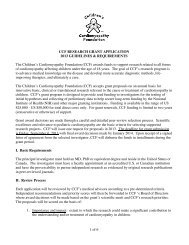Nutrition in pediatric cardiomyopathy - Children's Cardiomyopathy ...
Nutrition in pediatric cardiomyopathy - Children's Cardiomyopathy ...
Nutrition in pediatric cardiomyopathy - Children's Cardiomyopathy ...
You also want an ePaper? Increase the reach of your titles
YUMPU automatically turns print PDFs into web optimized ePapers that Google loves.
T.L. Miller et al. / Progress <strong>in</strong> Pediatric Cardiology 24 (2007) 59–7161discovery of pneumoncystis car<strong>in</strong>ii pneumonia <strong>in</strong> otherwisehealthy, but severely malnourished children <strong>in</strong> develop<strong>in</strong>gnations [22]. Investigators have shown that improv<strong>in</strong>g nutritionalstatus <strong>in</strong> malnourished and chronically ill children relates toimproved survival and decreased utilization of health careresources through lower hospitalization rates [23]. In anotherstudy evaluat<strong>in</strong>g cardiac outcomes <strong>in</strong> chronically ill children[24], nutritional status was a strong and <strong>in</strong>dependent predictor ofmortality and cardiac function. Thus, better nutritional status ofthe child (or adult) is related to the optimal function<strong>in</strong>g of theheart and other organ systems and eventual cl<strong>in</strong>ical outcomes[25,26].Growth failure is one of the most significant cl<strong>in</strong>icalproblems of children with <strong>cardiomyopathy</strong> with nearly onethirdof children with this disorder manifest<strong>in</strong>g some degree ofgrowth failure dur<strong>in</strong>g the course of their illness. In a recent<strong>in</strong>ternational study <strong>in</strong> Brazil [25], Azevedo determ<strong>in</strong>ed thatweight z-score was positively and <strong>in</strong>dependently correlated withsurvival <strong>in</strong> a chart review of 165 children with idiopathic dilated<strong>cardiomyopathy</strong> between 1979 and 2003. However, short of thisrestrospective chart review, there is a dearth of <strong>in</strong>formation onnutritional correlates to cardiac outcomes and function <strong>in</strong>children with <strong>cardiomyopathy</strong>. We have shown previously that<strong>in</strong> other models of chronic illness <strong>in</strong> children (humanimmunodeficiency virus <strong>in</strong>fection), that cardiac muscle massdoes not always waste <strong>in</strong> proportion to skeletal muscle [27].This suggests that neurohormonal <strong>in</strong>fluences may affect cardiacstatus to a greater extent than skeletal muscle. The underly<strong>in</strong>gcause of growth failure is usually due to persistent congestiveheart failure as a result of an overall poor response to medicaltreatment. Significant cardiac dysfunction <strong>in</strong> these children canresult <strong>in</strong> <strong>in</strong>creased metabolic demands, decreased food <strong>in</strong>takeand malabsorption of important nutrients. Growth failure ormalnutrition <strong>in</strong> children can lead to problems <strong>in</strong> virtually everyorgan system, with many of the effects only partially reversible.Thus <strong>cardiomyopathy</strong> may lead to growth problems, but growthproblems can lead to further complications that may directly or<strong>in</strong>directly impact on heart function, lead<strong>in</strong>g to a viciousdownward cycle (Fig. 1). These cl<strong>in</strong>ical manifestations <strong>in</strong>dicatethat growth patterns may be an important predictor of theoutcomes among CM patients or an important <strong>in</strong>dicator of theseverity of their <strong>cardiomyopathy</strong>. If this is so, then it becomesFig. 1. Vicious downward cycle of malnutrition <strong>in</strong> <strong>pediatric</strong> cardiomyopthy.apparent that cl<strong>in</strong>icians should be vigilant regard<strong>in</strong>g treatmentissues surround<strong>in</strong>g growth. The relationship between growthpatterns and echocardiographic f<strong>in</strong>d<strong>in</strong>gs is unknown.3. The effect of nutrients on cardiac endpo<strong>in</strong>ts <strong>in</strong> heartfailurePromotion of adequate nutrition beg<strong>in</strong>s with early detectionof children at risk for malnutrition. Optimal nutrition is critical<strong>in</strong> provid<strong>in</strong>g children the means to recover from their illness andto withstand the detrimental metabolic effects of aggressivetherapies. In theory, patients with heart failure who have either<strong>in</strong>sufficient fat mass (BMI b10% for age and sex) or excess fatmass (BMI ≥85% for age and sex) should have pooreroutcomes than patients with a BMI <strong>in</strong> the reference range(between 10% and 95%). Although excess body fat may<strong>in</strong>crease the risk of develop<strong>in</strong>g heart failure, evidence suggeststhat it may be beneficial once heart failure develops. Onemechanism may be that <strong>in</strong>creased body fat provides a metabolicreserve that allows overweight and obese patients to tolerate themetabolic/catabolic stress associated with heart failure pathologyfor a longer time [28]. Another potential mechanism isrelated to the hypothesized differences <strong>in</strong> pro<strong>in</strong>flammatorycytok<strong>in</strong>e activity between underweight and overweight/obese<strong>in</strong>dividuals with heart failure [29]. In addition to releas<strong>in</strong>gpro<strong>in</strong>flammatory cytok<strong>in</strong>es, adipose tissue is a source of anti<strong>in</strong>flammatorycytok<strong>in</strong>es. However, it is not known whether thepotential positive effects of excess body fat <strong>in</strong> patients withheart failure vary depend<strong>in</strong>g on body fat distribution. Ourcurrent recommendations focus on decreas<strong>in</strong>g body fataccumulation due to the known adverse effects and secondarydiseases that may develop from obesity. However, more studiesare needed <strong>in</strong> order to tease out the complex <strong>in</strong>teraction betweenobesity and active heart failure with particular focus on the<strong>pediatric</strong> population that has been often difficult to study ow<strong>in</strong>gto limited numbers of children available to study.3.1. MacronutrientsChildren with <strong>cardiomyopathy</strong>, with vary<strong>in</strong>g degrees ofcongestive heart failure, need to receive adequate calories tocompensate for their heart failure (that typically <strong>in</strong>creases basalenergy expenditure) as well as to provide additional calories fornormal growth. As mentioned previously, children <strong>in</strong> heartfailure often do not grow along expected standards for age andsex and poor growth may either contribute to poor cardiacfunction or be one result of it. Optimal caloric <strong>in</strong>take is usuallyestimated to be approximately 110–125% of the estimatedenergy requirement (EER) (Table 1) [30] for age and sex.However, greater or fewer calories may be required depend<strong>in</strong>gon the child's growth as a response to their <strong>in</strong>take; as normalnutrition is the balance between energy <strong>in</strong>take and energyutilization. Children who are <strong>in</strong> congestive heart failure oftenhave <strong>in</strong>creased metabolic rates due to the <strong>in</strong>creased work ofbreath<strong>in</strong>g, eat<strong>in</strong>g, or other rout<strong>in</strong>e activities of daily liv<strong>in</strong>g. Theymay also malabsorb critical nutrients as a result of heart failurelead<strong>in</strong>g to gut edema. Furthermore, anorexia, due to a variety of


